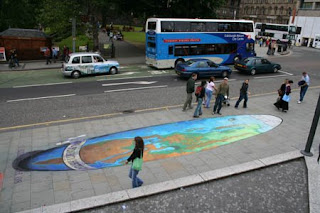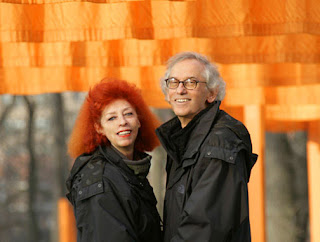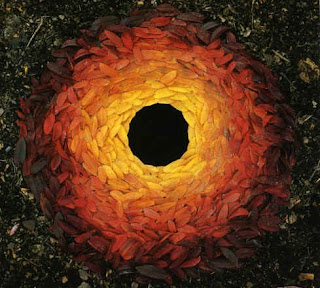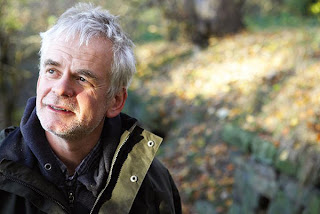Due to the ephemeral aspects of the Christo and Jeanne-Claude, Julian Beaver, Andy Goldsworthy’s artworks, photography plays a crucial role in capturing the beauty in the compositions they have created. As said by the Goldsworthy himself, "Each work grows, stays, decays – integral parts of a cycle which the photograph shows at its heights, marking the moment when the work is most alive. There is intensity about a work at its peak that I hope is expressed in the image. Process and decay are implicit." (Goldsworthy) The whole idea of all the artist’s artwork is to imprison an image, in the form of a photograph, of an artwork that will eventually decompose and cyclically become a part of the earth.
The importance of viewing these artists' ephemeral artwork increases because their work will not be around forever. As Christo says, “The fact that the work does not remain creates an urgency to see it. For instance, if someone were to tell you, ‘Oh, look on the right, there is a rainbow.’ You will never answer, ‘I will look at it tomorrow.’”
In the end, each of these artists’ work will deconstruct, whether the materials are recycled or the rain washes them away or they decompose, all the compositions will be returned the earth. Through photography, these fleeting pieces can be documented and shared will generations to come.
Tuesday, April 29, 2008
Monday, April 28, 2008
Julian Beaver
 The drawings of Julian Beaver are no ordinary sidewalk drawings; they are anamorphic, full color street chalk drawings. Beaver is an English artist who can take flat images and make them look three-dimensional, by the art of morphing. Anamorphic means optics having or producing unequal magnifications along two axes perpendicular to each other. By looking at the anamorphic images from the correct angle, the picture seems to defy the laws of perspective. Anamorphics are the reason Julian Beaver’s work has one successful vantage point, and from all other viewpoints the drawings read as stretched and askew.
The drawings of Julian Beaver are no ordinary sidewalk drawings; they are anamorphic, full color street chalk drawings. Beaver is an English artist who can take flat images and make them look three-dimensional, by the art of morphing. Anamorphic means optics having or producing unequal magnifications along two axes perpendicular to each other. By looking at the anamorphic images from the correct angle, the picture seems to defy the laws of perspective. Anamorphics are the reason Julian Beaver’s work has one successful vantage point, and from all other viewpoints the drawings read as stretched and askew.Julian is usually commissioned by companies to advertise their products. For example he created a Mountain Dew advertisement that also promoted the new movie Transformers. Using the New York City sidewalks as his canvas, Beaver’s drawings receive a great deal of attention from passers by, which is why he has been contract by many large name companies.
Just as the other ephemeral artwork I’ve mentioned, Julian Beaver is fighting weather in order to complete his chalk drawings. Most times he has a tent set up over this composition in order to protect it from the elements before he is finished. As all ephemeral artwork, the chalk drawings do not last forever and in the end remind us all that few things in life last forever.


Click here to see the creation of the Transformers, Mountain Dew Advertisement.
http://www.youtube.com/watch?v=ltZcnnBSbuk&feature=related
Christo & Jeanne Claude


The married duo creates environmental installation art. Their most recent installation is The Gates in New York City's Central Park. Although their work is visually impressive in terms of scale, the artists have repeatedly denied that their projects contain any deeper meaning than their immediate aesthetic. The purpose of their art is simply to make the world a "more beautiful place" or to create new ways of seeing familiar landscapes.
Being environmentalist artists, Christo and Jeanne-Claude recycle all the supplies used to make their installations. For example, in The Gates the saffron flowing fabric was sent to a firm in Pennysylvania, where it was shredded and respun. The vinyl framing was ground into half a million pounds of orange chips used to make fencing. The steel, even the screws, went to a scrap yard in New Jersey, where it was melted down and sold worldwide.
The idea of recycling all of the used materials creates an image of a circle: extracting resources from the earth, using them, and then decomposing them and letting them be reabsorbed into the earth . All of the resources used to build the installation are reused and in a sense return to the earth, just as our bodies will decay with time(as morbid as it might sound, it's true).
Sunday, April 27, 2008
Rowan Leaves Laid Around Hole

Rowan leaves laid around hole, made in the Yorkshire Sculpture Park in West Bretton, England, is one of Andy Goldsworthy’s most intriguing pieces and my favorite artwork of his. This piece is extremely eye catching because he has found intense brightly colored leaves to use as a medium. Deep red, hot ginger, and golden yellow foliage form a spinning circle that immediately is striking to me. The fact that the color is so well blended also adds to the aesthetic attractiveness of this photograph. This piece as a whole is appealing to me because of the powerful color and fine gradation.
Even though Rowan leaves laid around hole, photographed October 25th, 1987, is one of Goldsworthy’s older works, the themes found in this work can also be found in his more recent work today. There are two specific reoccurring topics that often appear in his work, mortality and repetition. The fact the Goldsworthy’s art is transient gives the viewer the feel of humanity, the idea that the materials have a state of being, certain to die eventually. He also uses repetition to keep the viewer’s eye captivated by moving it around the picture. Repetition and mortality, as themes, have been strongly expressed in all of his productions.
Andy Goldsworthy

With his use of found objects in nature and precise assembled compositions along with his strong photography, Andy Goldsworthy is an easy contemporary artist, sculptor, and photographer to like. Living and working in Penpoint, Scotland, Andy creates temporary assemblages using objects found from nature, such as leaves, petals, sticks, ice, and stones. After he crafts an arrangement that he considers successful, Goldsworthy uses color photography so that he can share his ephemeral artworks with others. The style of his impermanent artwork is classified as an American art movement, called “land art” (Lubow). A wide collection of his “land art” photography has been published in a book written by Goldsworthy called, “Andy Goldsworthy: A Collaboration with Nature.” Additionally there have been several other books and documentaries create about Andy Goldsworthy and his artwork.
Subscribe to:
Posts (Atom)